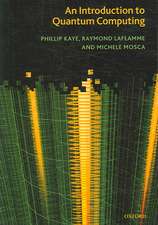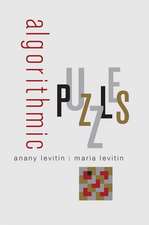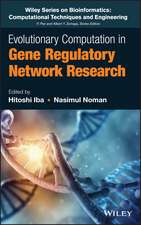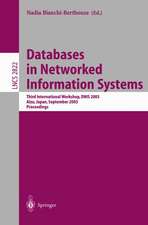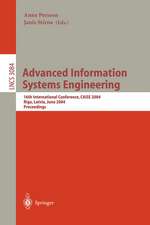Spatial Information Theory. Cognitive and Computational Foundations of Geographic Information Science: International Conference COSIT'99 Stade, Germany, August 25-29, 1999 Proceedings: Lecture Notes in Computer Science, cartea 1661
Editat de Christian Freksa, David M. Marken Limba Engleză Paperback – 11 aug 1999
Din seria Lecture Notes in Computer Science
- 20%
 Preț: 1061.55 lei
Preț: 1061.55 lei - 20%
 Preț: 307.71 lei
Preț: 307.71 lei - 20%
 Preț: 438.69 lei
Preț: 438.69 lei - 20%
 Preț: 645.28 lei
Preț: 645.28 lei -
 Preț: 410.88 lei
Preț: 410.88 lei - 15%
 Preț: 580.46 lei
Preț: 580.46 lei - 17%
 Preț: 427.22 lei
Preț: 427.22 lei - 20%
 Preț: 596.46 lei
Preț: 596.46 lei -
 Preț: 449.57 lei
Preț: 449.57 lei - 20%
 Preț: 353.50 lei
Preț: 353.50 lei - 20%
 Preț: 1414.79 lei
Preț: 1414.79 lei - 20%
 Preț: 309.90 lei
Preț: 309.90 lei - 20%
 Preț: 583.40 lei
Preț: 583.40 lei - 20%
 Preț: 1075.26 lei
Preț: 1075.26 lei - 20%
 Preț: 310.26 lei
Preț: 310.26 lei - 20%
 Preț: 655.02 lei
Preț: 655.02 lei - 20%
 Preț: 580.93 lei
Preț: 580.93 lei - 20%
 Preț: 340.32 lei
Preț: 340.32 lei - 18%
 Preț: 938.83 lei
Preț: 938.83 lei - 20%
 Preț: 591.51 lei
Preț: 591.51 lei - 15%
 Preț: 438.59 lei
Preț: 438.59 lei - 20%
 Preț: 337.00 lei
Preț: 337.00 lei -
 Preț: 389.48 lei
Preț: 389.48 lei - 20%
 Preț: 607.39 lei
Preț: 607.39 lei - 20%
 Preț: 1024.44 lei
Preț: 1024.44 lei - 20%
 Preț: 579.30 lei
Preț: 579.30 lei - 20%
 Preț: 763.23 lei
Preț: 763.23 lei - 20%
 Preț: 453.32 lei
Preț: 453.32 lei - 20%
 Preț: 575.48 lei
Preț: 575.48 lei - 20%
 Preț: 585.88 lei
Preț: 585.88 lei - 20%
 Preț: 825.93 lei
Preț: 825.93 lei - 20%
 Preț: 763.23 lei
Preț: 763.23 lei - 17%
 Preț: 360.19 lei
Preț: 360.19 lei - 20%
 Preț: 1183.14 lei
Preț: 1183.14 lei - 20%
 Preț: 340.32 lei
Preț: 340.32 lei - 20%
 Preț: 504.57 lei
Preț: 504.57 lei - 20%
 Preț: 369.12 lei
Preț: 369.12 lei - 20%
 Preț: 583.40 lei
Preț: 583.40 lei - 20%
 Preț: 343.62 lei
Preț: 343.62 lei - 20%
 Preț: 350.21 lei
Preț: 350.21 lei - 20%
 Preț: 764.89 lei
Preț: 764.89 lei - 20%
 Preț: 583.40 lei
Preț: 583.40 lei - 20%
 Preț: 649.49 lei
Preț: 649.49 lei - 20%
 Preț: 341.95 lei
Preț: 341.95 lei - 20%
 Preț: 238.01 lei
Preț: 238.01 lei - 20%
 Preț: 538.29 lei
Preț: 538.29 lei
Preț: 342.46 lei
Preț vechi: 428.07 lei
-20% Nou
Puncte Express: 514
Preț estimativ în valută:
65.53€ • 68.42$ • 54.23£
65.53€ • 68.42$ • 54.23£
Carte tipărită la comandă
Livrare economică 04-18 aprilie
Preluare comenzi: 021 569.72.76
Specificații
ISBN-13: 9783540663652
ISBN-10: 3540663657
Pagini: 500
Ilustrații: XIV, 486 p.
Dimensiuni: 155 x 235 x 26 mm
Greutate: 0.69 kg
Ediția:1999
Editura: Springer Berlin, Heidelberg
Colecția Springer
Seria Lecture Notes in Computer Science
Locul publicării:Berlin, Heidelberg, Germany
ISBN-10: 3540663657
Pagini: 500
Ilustrații: XIV, 486 p.
Dimensiuni: 155 x 235 x 26 mm
Greutate: 0.69 kg
Ediția:1999
Editura: Springer Berlin, Heidelberg
Colecția Springer
Seria Lecture Notes in Computer Science
Locul publicării:Berlin, Heidelberg, Germany
Public țintă
ResearchCuprins
Landmarks and Navigation.- Large-Scale Navigation: The Insect Case.- Route Navigation Using Motion Analysis.- The Nature of Landmarks for Real and Electronic Spaces.- Route Directions.- Pictorial and Verbal Tools for Conveying Routes.- Elements of Good Route Directions in Familiar and Unfamiliar Environments.- The Production of Route Instructions in Underground and Urban Environments.- Abstraction and Spatial Hierarchies.- One Step up the Abstraction Ladder: Combining Algebras - From Functional Pieces to a Whole.- Formalizing Regions in the Spatial Semantic Hierarchy: an AH-Graphs implementation approach.- Abstraction, Levels of Detail, and Hierarchies in Map Series.- Topological Relations in Hierarchical Partitions.- Spatial Reasoning Calculi.- A Predication Calculus for Qualitative Spatial Representations.- Simple Models for Simple Calculi.- Terminological Default Reasoning about Spatial Information: A First Step.- Reasoning about Cardinal Directions Using Grids as Qualitative Geographic Coordinates.- Ontology of Space.- The Role of Identity Conditions in Ontology Design.- Atomicity vs. Infinite Divisibility of Space.- The Mereotopology of Discrete Space.- Agglomerations.- Ontology and Geographic Objects: An Empirical Study of Cognitive Categorization.- Modes of Connection.- Visual Representation and Reasoning.- Representation and Reasoning about Shapes: Cognitive and Computational Studies in Visual Reasoning in Design.- An Algebraic Interpretation of Semantic Networks.- Data Characterization Schema for Intelligent Support in Visual Data Analysis.- Maps and Routes.- Recognition—Triggered Response and the View—Graph Approach to Spatial Cognition.- A Formal Model of the Process of Wayfinding in Built Environments.- A Spatial Model Based on the Notions of SpatialConceptual Map and of Object’s Influence Areas.- Granularity and Qualitative Abstraction.- Granulation for Graphs.- On Ontology and Epistemology of Rough Location.- Qualitative Spatial Representation for Situational Awareness and Spatial Decision Support.- Qualitative Motion Representation in Egocentric and Allocentric Frames of Reference.
Caracteristici
Includes supplementary material: sn.pub/extras


